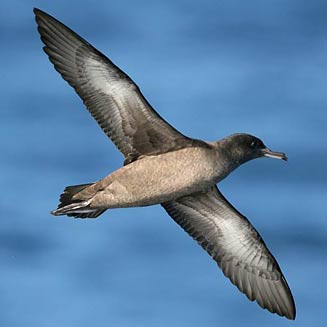|
Puffinus griseus (Sooty
shearwater)
Malbaatjie [Afrikaans]; Grauwe pijlstormvogel [Dutch];
Puffin fuligineux [French]; Dunkler sturmtaucher [German]; Pardela-preta
[Portuguese]
Life
> Eukaryotes >
Opisthokonta
> Metazoa (animals) >
Bilateria >
Deuterostomia > Chordata >
Craniata > Vertebrata (vertebrates) > Gnathostomata (jawed
vertebrates) > Teleostomi (teleost fish) > Osteichthyes (bony fish) > Class:
Sarcopterygii (lobe-finned
fish) > Stegocephalia (terrestrial
vertebrates) > Tetrapoda
(four-legged vertebrates) > Reptiliomorpha > Amniota >
Reptilia (reptiles) >
Romeriida > Diapsida > Archosauromorpha > Archosauria >
Dinosauria
(dinosaurs) > Saurischia > Theropoda (bipedal predatory dinosaurs) >
Coelurosauria > Maniraptora > Aves
(birds) > Order: Ciconiiformes
> Family: Procellariidae
 |
 |
|
Sooty shearwater, offshore from Cape Town, South Africa. [photo
Trevor Hardaker ©] |
Sooty shearwater, offshore from Cape Town, South Africa. [photo Trevor Hardaker ©] |
Distribution and habitat
Breeds on islands off southern South America, south-eastern
Australia, Tasmania and New Zealand as well as on the Falklands and Tristan da
Cunha. In the non-breeding season it disperses across the Pacific, Atlantic and
Southern Oceans down to about 65° South, including southern African waters. Here
it is abundant off the western and southern coasts from central Namibia to the
Western and Eastern Cape, in fact it is the most common winter seabird in this
area. It is less common further out to sea, while completely absent east of
Mozambique.
Movements and migrations
The breeding season is from September-April,
after which it migrates to the North Atlantic and North Pacific
Oceans. Juveniles and non-breeding adults are present year-round in
southern African waters, although the latter are thought to
subsequently migrate north.
Food
It mainly eats small fish, supplemented with crustaceans,
crab larvae, tunicates and trawler discards, doing most of it foraging by
grabbing prey from the water surface and plunge-diving up to a depth of about 67
metres. In order to do this it dives in a zig-zag pattern, which reduces
bouyancy by expelling air trapped in its feathers. It also associates with Cape
fur seals (Arctocephalus
pusillus), tunas (Thunnus), Common dolphins (Delphinus
deplhis), Dusky dolphins (Lagenorhynchus
obscurus) and Bryde's whales (Balaenoptera
edeni), catching prey that they drive to they drive to the surface. The following food items have been recorded
in its diet:
- fish
- Engraulis encrasicolus (Anchovies)
- Maurolicus muelleri (Lightfish)
- Lampanyctodes hectoris (lanternfish)
- crustaceans
- Squilla armata (mantis shrimps)
- Euphausia lucens (euphausiids)
- crab larvae
- amphipods
- pelagic turnicates (Thaliacea)
- trawler discards
Threats
Not threatened, with a world population of approximately 20
million individuals, although its population is decreasing rapidly. This thought
to be caused by drift net fishery (which killed about 350 000 birds annually in
the North Pacific in the 1980s), coupled with human exploitation and introduced
predators at its breeding colonies.
References
-
Hockey PAR, Dean WRJ and Ryan PG 2005. Roberts
- Birds of southern Africa, VIIth ed. The Trustees of the John Voelcker
Bird Book Fund, Cape Town.
|
